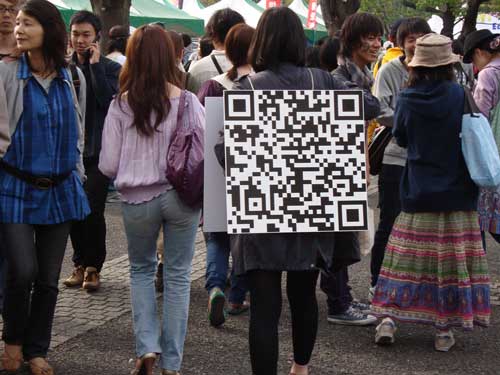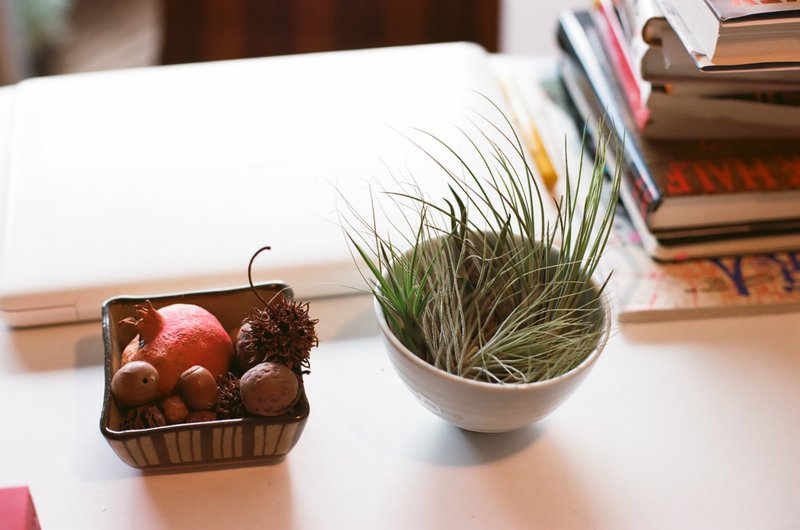
机の上にあるエアプラントや種子やザクロがあると、仕事が面白くなります。
At some point, my desk gained a bowl of air plants and small collection of foraged Tokyo nuts, seeds and a persimmon (pomegranate). Even in a small space, it’s nice to have nature near the computer.

This year the plantings on the balcony seem extra thick. The twin towers in the distance are the offices of the Tokyo Metropolitan Government.
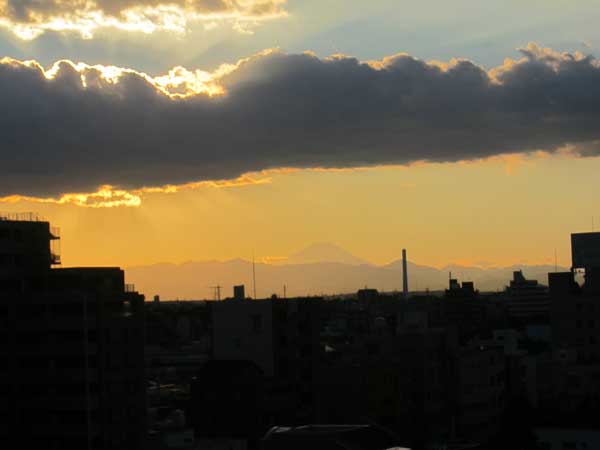
空と都市の対照がきれいです。この雲は本当か偽物のどちらでしょうか。
Fall brings clear skies and dramatic clouds. How come the top looks like a natural wonder and the city below is littered with antennas, utility poles, and a giant incinerator?

都市計画が良くないのに、東京生活は素晴らしいと友達に話します。最近、TEDxSeedsに行って、横浜の港でまた遊びました。大さん橋という国際埠頭はきれいな建築や商売や水辺公園を組み合わせています。横浜がこんな新しい開いたスペースを作られるならば、東京もできるはずです。
I often tell people that Tokyo’s urban life is wonderful in spite of city planning. On the one hand, this view valorizes the activities of everyday people in making public spaces alive with plants, care, and community. On the other hand, it also expresses a resignation that city leaders cannot or will not improve city life.
Recently I attended TEDxSeeds at Yokohama’s restored port. In addition to wonderful historic buildings that are preserved and reused, the entire port area has a revitalized public park and waterfront promenade. One of the most spectacular public places is the undulating rooftop park above the International Ferry Terminal, designed by London’s Foreign Office Architects; in Japanese it’s called Osanbashi.
This is a bold example of creating a new open space that combines commerce (the business of loading and unloading passenger ships) with a place for residents and visitors to stroll and relax on the waterfront. I heard one Yokohama resident refer to the building as “the whale” building because of its curvy surface.
If Tokyo city leaders thought big, what kind of new public spaces could be created here? How could some of its past be made visible and accessible today? What natural resources could be reclaimed with great architecture and some vision? It seems in terms of city planning that Japan’s other cities are more dynamic and more forward-looking than its capital.

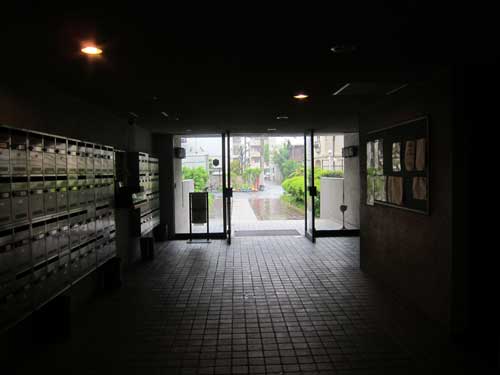
アパートの入り口から見えた、雨降りの朝の景色です。節電ですから、電気をほとんど消しています。中と外の対象がはっきりしていますね。
This is the view from my apartment building lobby on a rainy spring day. Because of energy conservation, many lights are turned off. This increases the contrast between indoors and outdoors.
I walk through this lobby every day, and rarely think about it or consider taking a photo. Recently, I participated in the Xerox and City photo workshop at Vacant, led by Hirano Taro and organzized by Too Much magazine as part of their Romantic Geographies series. We were asked to take photos of our breakfast and then our trip to the workshop in Harajuku. It made me think more about spaces that become automatic or ignored.
Tokyo residents are more aware of energy use and lighting now. Many parts of the city are less brighly lit: from billboards to train stations to residences. By lowering our lighting, we are more attuned to natural cycles, and more sensitive to the boundaries between private and public, indoor and outdoor, personal and shared resources.

ありきたりの渋谷のビルのなかで、木や石や桜の枝のような自然の素材がおしゃれでなつかしい雰囲気を作っています。
[Date: March 7, 2011]
I love how this ordinary Shibuya building uses minimal natural materials, including wood, stone, and sakura branches, to create an elegant and nostalgic atmosphere.
原発についてたくさん勉強になりましたけれども、毎日の生活とエネルギーの本当のコストの問題が残っています。
A fascinating short video from IDG News Service’s @martyn_williams shows the inside of a functioning nuclear power plant in Japan. It’s Kashiwazaki Kariwa, the world’s largest nuclear plant, on the Japan Sea, also known as the East Sea of Korea.
In the past two weeks, we have all learned many details about nuclear power generation: from containment vessels to doughnut-shaped torus, steam venting, cooling pools, basement pumps and generators, and dangers from radioactive iodine and cesium. While the Daichi survived the earthquake, several days without electricity led to pressure build-up, exposed fuel rods, explosions, and radioactive releases.
Most Japanese school children are given tours of nuclear facilities to encourage familiarization and acceptance. Watching the video above, I am struck by the incongruity of these images of rational organization with the recent realization that a lack of power can quickly turn these engineering marvels into a grave threat to human existence.
It is interesting that the video above, and I am certain the hundreds of school tours, fail to mention that the reactors serve a second and equally dangerous function: they are the storage locations for spent nuclear rods. While the active rods have control rods and secured cases, the spent rods seem to be in less protected parts of the reactors.
The explosions at the Daichi nuclear power plant in Fukushima have literally blown the lid off a scary reality that is normally kept far from conscious thinking. Everyone knows that nuclear waste and the long-term dangers it poses are the by-product of this “clean,” low carbon energy. What is less known is that these spent rods remain near population centers and alongside ocean coasts that routinely experience tsunamis and earthquakes. They remain hidden from view within the plants because the rods are difficult to transport safely and few communities would welcome them.
I expect that as the crisis becomes less acute, there will be more attention to the questions of how much energy we need, how to balance what is possible with what is prudent, and how to make visible the true costs of energy production, including the wars used to “secure” petroleum from hostile regions, and the potential contamination of people and land from nuclear power and waste.
In the coming weeks, this blog will focus on recovery from the nuclear crisis, including increased city bicycling, reduced power consumption, and other positive developments. I will also show signs of Tokyo’s spring, and other evidence that the natural world continues in spite of human activity.


Miniature pine forest outside Japan Supreme Court. In 1970s, traditional garden joined Brutalist architecture. Would love to see traditional garden with urban forest today.
最高裁判所の外にすてきな松の小さな森がある。70年代に日本庭園とブルータリスム建築は一緒になった。将来は日本庭園と都市の森は一緒になれるかな。
Walking in Chiyoda-ku opposite the Imperial Palace, I saw this forest of beautiful stunted pine trees above a stone wall. At eye level, there appear to be hundreds of carefully twisted pines whose canopy is less than one meter from the ground. Behind this gorgeous sea of needles is the Supreme Court of Japan (最高裁判所), a 1974 Brutalist concrete building that won awards for its architect Shinichi Okada.
I love the stone wall and the pine forest. In my dream, the once avant-guarde building could regain its ぷprominence by using the concrete structure to support a dense urban forest on its walls and roof. The wildness of the forest hill would contrast nicely with the austere pine forest serving as a formal moat to this newly enlivened public building. The contrast would be magnificent.
While I love the chaos of DIY gardens and the lushness of urban forests, there is also room for traditional Japanese gardens and techniques in the urban landscape, particularly around important public buildings. The contrast between heavily manipulated and more natural landscapes is a new concept at which Tokyo can excel.


I love this rose-covered homeware shop in Nishi Ogikubo. It’s near an antique shop owned by a friend of the family. By June of each year, it is covered in gorgeous blooms. I particularly like the natural look of climbing roses (versus tea roses). The side view is even more exuberant!


Tokyo’s mild winter is amazing. All these photos of winter flowers are from yesterday, January 20, 2010. Ranging from natural to forced, outdoors to indoors, the flowers include early plum blossom along an urban path to a red tulip in a sidewalk garden, to a mini daffodil at home.
 Starting a week ago, this plum tree along a walking path to Nakano JR station began opening its petals. The tree extends from a private garden into a public path. After November and December’s camellias (and my balcony pink camellia is still blooming), the winter plums suggest that there is no month in Tokyo without flowers blooming naturally. My husband saw bright green mejiro birds in the tree later that day.
Starting a week ago, this plum tree along a walking path to Nakano JR station began opening its petals. The tree extends from a private garden into a public path. After November and December’s camellias (and my balcony pink camellia is still blooming), the winter plums suggest that there is no month in Tokyo without flowers blooming naturally. My husband saw bright green mejiro birds in the tree later that day.

 I also noticed these bright red tulips in a Nakano sidewalk garden that I often pass. It’s the garden that was growing rice in styrofoam containers last year. The gardener has planted some bulbs, but she’s also added some hothouse-forced bulbs to her charming public garden. Because frost is so rare, the tulips can thrive even in mid-winter.
I also noticed these bright red tulips in a Nakano sidewalk garden that I often pass. It’s the garden that was growing rice in styrofoam containers last year. The gardener has planted some bulbs, but she’s also added some hothouse-forced bulbs to her charming public garden. Because frost is so rare, the tulips can thrive even in mid-winter.
I also saw another neighbor cutting roses from her sidewalk garden. Pansies are also common in winter.
Lastly, inspired by all this winter color, I bought some mini-daffodils for my home. Indoors, they go from bud to bloom incredibly fast. The bright yellow cheers up the apartment and fools me into thinking that spring is not so far away.

On a beautiful warm November day, I discovered Tokyo University’s Sanshiro-ike garden. I had a few moments before a meeting, and saw on the campus map that there was a central garden on the main campus. I had assumed it would be a formal garden.

I was very surprised to descend a small hillside and encounter this natural looking pond. Looking in all directions, one sees only trees, water and sky, despite the compact size of the garden. Even on a warm weekend day with early fall foliage, few visitors were there. I was enchanted by the incredibly natural and removed-from-the-city feeling in this garden inside central Tokyo and Japan’s most famous university.

It takes a lot of artifice to make a city garden look so natural. The waterfall is amazing.
Continue reading to see some more images from Tokyo University, aka Todai.

Today’s New York Times has a great “Room for Debate” feature where four cultural experts discuss the beauty of the Japanese bento box. Although seemingly off-topic from Tokyo Green Space, the discussion expresses relevant cultural aesthetics and the importance of beauty, simplicity, and care.
John Maeda, the president of the Rhode Island School of Design, talks about simplicity and making due in an island nation with limited natural resources. I like his view that Japanese value “making less into more,” and traces bento creation to Kyoto food, a fanciful illusion that masks limited food resources.
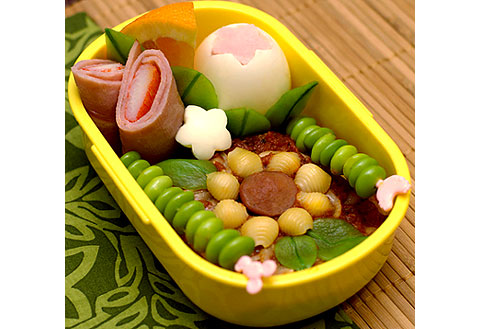
Kenya Hara, art director of Muji and professor of Musashino Art University, talks about shokunin kishitsu, or craftsman’s spirit. By cleaning carefully, working diligently, or preparing lunch boxes with creativity, airport cleaners, construction workers and home-makers make the mundane into something beautiful.
I also like how he claims Japanese have a special ability, “an incapacity to see ugliness,” that allows them to ignore urban chaos, ugly architecture and bad signage. In the drabbest office or construction environment, there is still a space to enjoy a perfect bento lunch.
It is easy to see how some of these ideas are expressed in the beautification of public spaces: ordinary people working within the constraints of an often poorly designed urban landscape, creating small vignettes of beauty with a mix of artistry and care, and sharing these creations with minimal self-importance.
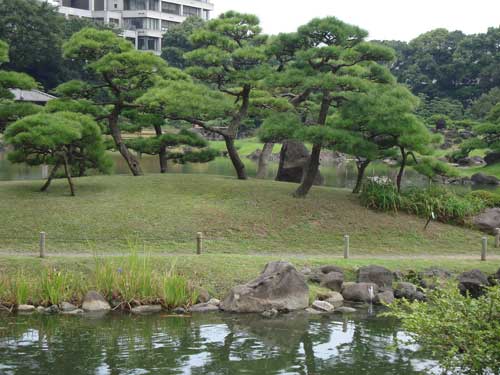
Traditional Japanese garden Kyu Shiba Rikyu dates to 1678 when land reclaimed from Tokyo Bay became the residence of Okugawa Tadatamo, an official of Tokugawa Shogunate. Kyu Shiba Rikyu is one of Tokyo’s oldest gardens, along with Koishikawa Korakuen. Kyu Shiba Rikyu was destroyed by fire in the 1923 earthquake, rebuilt and gifted by the Emperor as a city park.
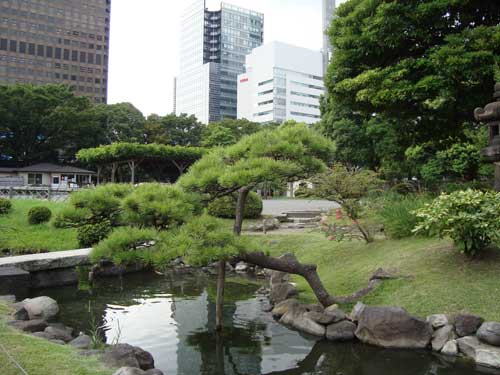
Today this stroll garden with a focal pond and two small islands sits steps from Hamamatsuchou station, and surrounded by office buildings, bullet trains, the JR Yamanote line, a monorail, elevated train, and two elevated highways. The pond reflects manicured black pines, office towers and billboards. There is also a very elegant archery range with grass lawn, tatami seating area, and targets inked by hand. (See photos after the jump below).
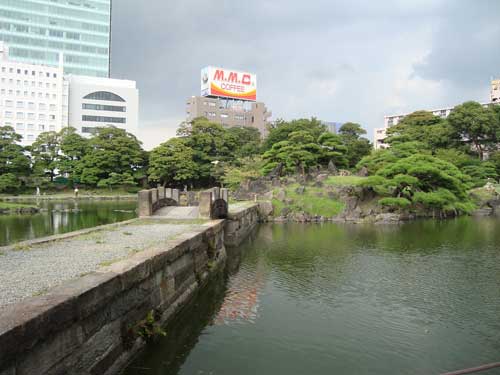
The pond and island were created over 400 years ago to recall China’s Seiko Lake (Xi Hu) and Reizan sacred mountain in Hangzhou (Zhejiang). Like at Koishikawa Korakuen, Kyu Shiba Rikyu was created at a time when garden design, philosophy, literature, and painting all borrowed heavily from China. Given our last century’s conflicts between Japan and China, is it too much to hope for artistic borrowings in this century?
A wonderful garden diplomacy would be a photographic exploration of these 400 year old Japanese gardens and the Chinese landscapes that inspired them. How have the natural and designed environments changed? What contemporary landscapes could inspire today’s art exchanges?
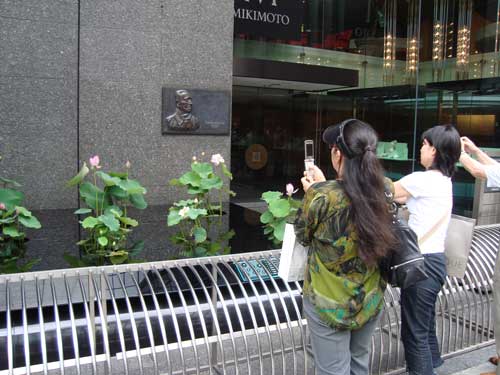
Mikimoto in Ginza often has season flower displays that attract crowds of camera phone fans. This month it is lotus. I am always amazed at how Tokyoites are so enraptured at flower displays, displaying a hunger and appreciation for natural beauty in the city.
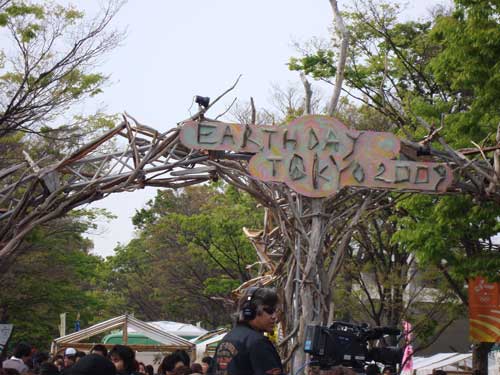
Today and tomorrow in Yoyogi Park, more than 100,000 people are expected to attend Earth Day Tokyo. Hundreds of booths offered everything from natural maternity to bamboo crafts, organic foods and clothes, bio-diesel vehicles, free Tibet, save the baby seals, music ranging from all girl rock band to Hawaiian song, more cute and strange mascots than you can imagine, and 20 to 30 year old hippies as far as the eye could see. It was great to see so many city people concerned about the environment.
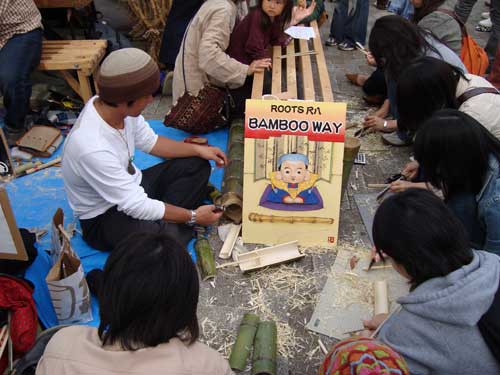
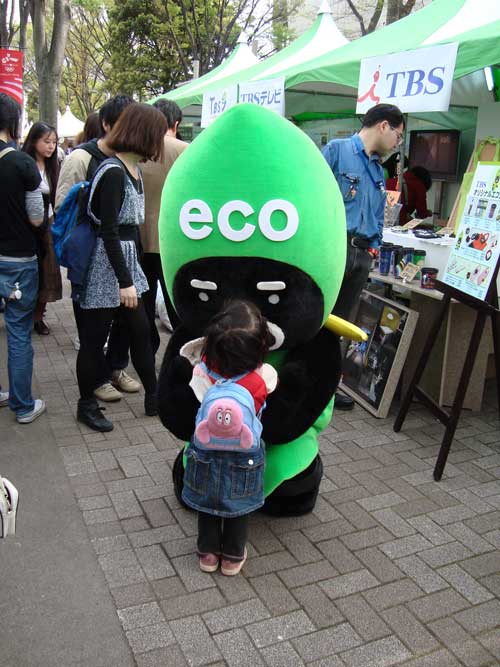
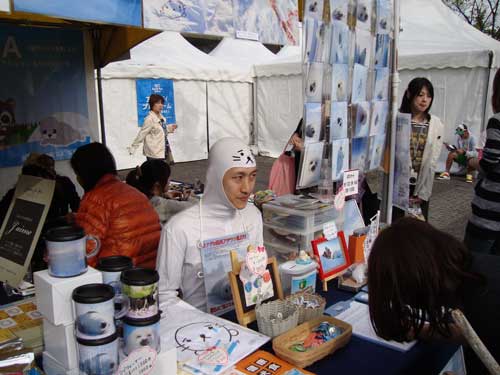
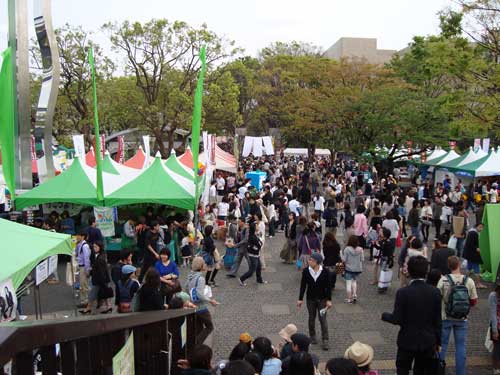
The most mysterious promotion was this human QR billboard. I guess you need to have a cellphone that can read this internet code to find out what she is advocating.
